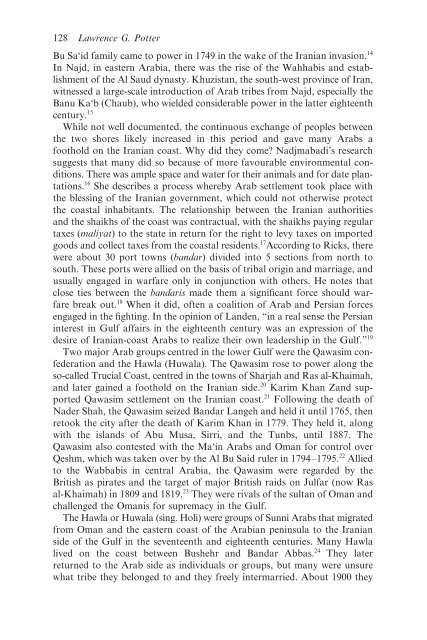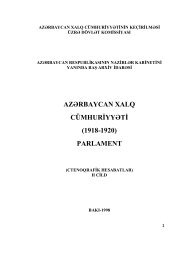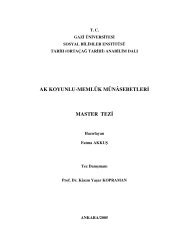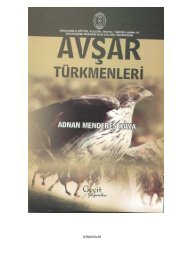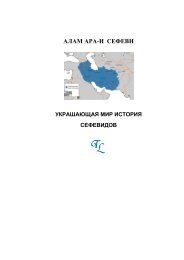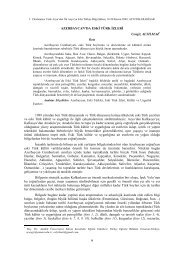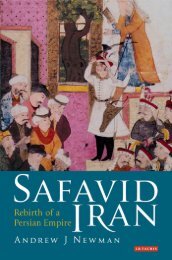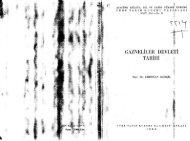War and Peace in Qajar Persia: Implications Past and ... - Oguzlar.az
War and Peace in Qajar Persia: Implications Past and ... - Oguzlar.az
War and Peace in Qajar Persia: Implications Past and ... - Oguzlar.az
- No tags were found...
Create successful ePaper yourself
Turn your PDF publications into a flip-book with our unique Google optimized e-Paper software.
128 Lawrence G. PotterBu Sa‘id family came to power <strong>in</strong> 1749 <strong>in</strong> the wake of the Iranian <strong>in</strong>vasion. 14In Najd, <strong>in</strong> eastern Arabia, there was the rise of the Wahhabis <strong>and</strong> establishmentof the Al Saud dynasty. Khuzistan, the south-west prov<strong>in</strong>ce of Iran,witnessed a large-scale <strong>in</strong>troduction of Arab tribes from Najd, especially theBanu Ka‘b (Chaub), who wielded considerable power <strong>in</strong> the latter eighteenthcentury. 15While not well documented, the cont<strong>in</strong>uous exchange of peoples betweenthe two shores likely <strong>in</strong>creased <strong>in</strong> this period <strong>and</strong> gave many Arabs afoothold on the Iranian coast. Why did they come? Nadjmabadi’s researchsuggests that many did so because of more favourable environmental conditions.There was ample space <strong>and</strong> water for their animals <strong>and</strong> for date plantations.16 She describes a process whereby Arab settlement took place withthe bless<strong>in</strong>g of the Iranian government, which could not otherwise protectthe coastal <strong>in</strong>habitants. The relationship between the Iranian authorities<strong>and</strong> the shaikhs of the coast was contractual, with the shaikhs pay<strong>in</strong>g regulartaxes (maliyat) to the state <strong>in</strong> return for the right to levy taxes on importedgoods <strong>and</strong> collect taxes from the coastal residents. 17 Accord<strong>in</strong>g to Ricks, therewere about 30 port towns (b<strong>and</strong>ar) divided <strong>in</strong>to 5 sections from north tosouth. These ports were allied on the basis of tribal orig<strong>in</strong> <strong>and</strong> marriage, <strong>and</strong>usually engaged <strong>in</strong> warfare only <strong>in</strong> conjunction with others. He notes thatclose ties between the b<strong>and</strong>aris made them a significant force should warfarebreak out. 18 When it did, often a coalition of Arab <strong>and</strong> <strong>Persia</strong>n forcesengaged <strong>in</strong> the fight<strong>in</strong>g. In the op<strong>in</strong>ion of L<strong>and</strong>en, “<strong>in</strong> a real sense the <strong>Persia</strong>n<strong>in</strong>terest <strong>in</strong> Gulf affairs <strong>in</strong> the eighteenth century was an expression of thedesire of Iranian-coast Arabs to realize their own leadership <strong>in</strong> the Gulf.” 19Two major Arab groups centred <strong>in</strong> the lower Gulf were the Qawasim confederation<strong>and</strong> the Hawla (Huwala). The Qawasim rose to power along theso-called Trucial Coast, centred <strong>in</strong> the towns of Sharjah <strong>and</strong> Ras al-Khaimah,<strong>and</strong> later ga<strong>in</strong>ed a foothold on the Iranian side. 20 Karim Khan Z<strong>and</strong> supportedQawasim settlement on the Iranian coast. 21 Follow<strong>in</strong>g the death ofNader Shah, the Qawasim seized B<strong>and</strong>ar Langeh <strong>and</strong> held it until 1765, thenretook the city after the death of Karim Khan <strong>in</strong> 1779. They held it, alongwith the isl<strong>and</strong>s of Abu Musa, Sirri, <strong>and</strong> the Tunbs, until 1887. TheQawasim also contested with the Ma‘<strong>in</strong> Arabs <strong>and</strong> Oman for control overQeshm, which was taken over by the Al Bu Said ruler <strong>in</strong> 1794–1795. 22 Alliedto the Wabbabis <strong>in</strong> central Arabia, the Qawasim were regarded by theBritish as pirates <strong>and</strong> the target of major British raids on Julfar (now Rasal-Khaimah) <strong>in</strong> 1809 <strong>and</strong> 1819. 23 They were rivals of the sultan of Oman <strong>and</strong>challenged the Omanis for supremacy <strong>in</strong> the Gulf.The Hawla or Huwala (s<strong>in</strong>g. Holi) were groups of Sunni Arabs that migratedfrom Oman <strong>and</strong> the eastern coast of the Arabian pen<strong>in</strong>sula to the Iranianside of the Gulf <strong>in</strong> the seventeenth <strong>and</strong> eighteenth centuries. Many Hawlalived on the coast between Bushehr <strong>and</strong> B<strong>and</strong>ar Abbas. 24 They laterreturned to the Arab side as <strong>in</strong>dividuals or groups, but many were unsurewhat tribe they belonged to <strong>and</strong> they freely <strong>in</strong>termarried. About 1900 they


